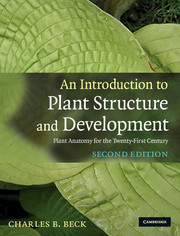Book contents
- Frontmatter
- Contents
- Preface to the second edition
- Preface
- Acknowledgements
- General references
- Chapter 1 Problems of adaptation to a terrestrial environment
- Chapter 2 An overview of plant structure and development
- Chapter 3 The protoplast of the eukaryotic cell
- Chapter 4 Structure and development of the cell wall
- Chapter 5 Meristems of the shoot and their role in plant growth and development
- Chapter 6 Morphology and development of the primary vascular system of the stem
- Chapter 7 Sympodial systems and patterns of nodal anatomy
- Chapter 8 The epidermis
- Chapter 9 The origin of secondary tissue systems and the effect of their formation on the primary body in seed plants
- Chapter 10 The vascular cambium: structure and function
- Chapter 11 Secondary xylem
- Chapter 12 The phloem
- Chapter 13 Periderm, rhytidome, and the nature of bark
- Chapter 14 Unusual features of structure and development in stems and roots
- Chapter 15 Secretion in plants
- Chapter 16 The root
- Chapter 17 The leaf
- Chapter 18 Reproduction and the origin of the sporophyte
- Glossary
- Index
- References
Chapter 1 - Problems of adaptation to a terrestrial environment
Published online by Cambridge University Press: 05 June 2012
- Frontmatter
- Contents
- Preface to the second edition
- Preface
- Acknowledgements
- General references
- Chapter 1 Problems of adaptation to a terrestrial environment
- Chapter 2 An overview of plant structure and development
- Chapter 3 The protoplast of the eukaryotic cell
- Chapter 4 Structure and development of the cell wall
- Chapter 5 Meristems of the shoot and their role in plant growth and development
- Chapter 6 Morphology and development of the primary vascular system of the stem
- Chapter 7 Sympodial systems and patterns of nodal anatomy
- Chapter 8 The epidermis
- Chapter 9 The origin of secondary tissue systems and the effect of their formation on the primary body in seed plants
- Chapter 10 The vascular cambium: structure and function
- Chapter 11 Secondary xylem
- Chapter 12 The phloem
- Chapter 13 Periderm, rhytidome, and the nature of bark
- Chapter 14 Unusual features of structure and development in stems and roots
- Chapter 15 Secretion in plants
- Chapter 16 The root
- Chapter 17 The leaf
- Chapter 18 Reproduction and the origin of the sporophyte
- Glossary
- Index
- References
Summary
Perspective: the origin of vascular plants
Land plants, plants that complete their life cycle entirely in a terrestrial environment, are represented largely by bryophytes and vascular plants. In all taxa except seed plants, however, at least a thin film of water is required for fertilization; and even in two primitive groups of seed plants, the cycads and Ginkgo, fertilization is by free-swimming spermatozoids released into a liquid medium in the archegonial chamber. A few angiosperms, although terrestrial in origin, have reverted to an aquatic existence.
Vascular plants are by far the dominant groups on the Earth comprising over 255,000 species in contrast to about 22,000 species of bryophytes and approximately 20,000 species of algae. The first vascular plants appear in the fossil record in the late Silurian, about 420 million years ago, but their green algal ancestors are thought to have appeared nearly 400 million years earlier! Shared features comprise the major evidence that vascular plants, possibly also bryophytes, evolved from green algae: both synthesize chlorophylls a and b, both store true starch in plastids; both have motile cells with whiplash flagella, and both (but only a few green algae) are characterized by phragmoplast and cell plate formation following mitosis. A green alga, with these and other significant characteristics, that may provide a model of an algal ancestor of vascular plants is Coleochaete, a member of the Charophyceae.
- Type
- Chapter
- Information
- An Introduction to Plant Structure and DevelopmentPlant Anatomy for the Twenty-First Century, pp. 1 - 7Publisher: Cambridge University PressPrint publication year: 2010

